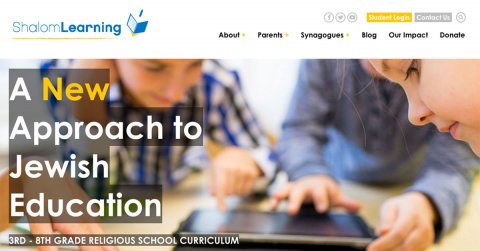Online/Blended Learning Model: TiLearn
Temple Israel of the City of NY, New York, NY
Model Description | Update 2017

Model Summary:
TiLearn is a flexible option for learners in grades 4-6 to experience blended learning by studying onsite one day a week and in a virtual classroom another day a week. Using the Shalom Learning platform for Judaic studies virtual learning classes of 15-20 students “come together” on Sunday mornings and experience what the latest technology can offer in a synchronous learning environment. On Wednesdays they come to the synagogue to learn and pray with their peers.
Who are the Learners?
-
TiLearn is open to learners in 4th-6th grades as an option.
- Typically, there are two or three classes per grade, with 12-20 students in each class and 50-65% of the learners opting in each year.
Who are the Educators/Learning Facilitators?
-
The Youth Director/Assistant Principal spear heads the program and oversees it.
- Temple Israel hires religious school teachers who will facilitate learning in both the virtual classroom as well as on site so the students have the same teacher both times. They feel this is important for consistency and that it fosters building relationships and community.
When Does the Learning Happen?
- Wednesdays from 4:15-5:45 p.m. and Sunday from 9-10:15 a.m.
Where Does the Learning Happen?
The learning happens in classrooms and in learners’ own homes. The weekday learning takes place in the synagogue and weekend time is in the home.
What is the Learning? How is It Designed?
Temple Israel uses the Shalom Learning (shalomlearning.com/curriculum) curriculum based on 7 values as well as the Torah Aura Hebrew packet system. Both are done in an online learning mode.
What Were You Trying to Achieve with this Model?
-
They wanted to innovate; to create something that was new and different that would bring excitement back to Jewish learning and engage students on a whole new level.
- They hope that their students will look back on their time at Temple Israel and won’t think that religious school was boring; but rather that they liked it and are left with a really good feeling.
Key First Steps and Recruitment Plan:
- Everything is done through word of mouth. There is a flyer for TiLearn and they have an orientation meeting to learn more with a PowerPoint.
Role of governance and Clergy:
One member of the clergy team is a teacher in the model. On Wednesdays, all 4th-6th graders participate in tefilah led by the Rabbi Educator.
Budget:
-
The cost for Shalom Learning is different for each congregation.
-
Teachers are paid $55 to $75 an hour. Since teachers are using Shalom Learning, they are not designing original curriculum, thereby shortening their preparation time.
-
Teachers are paid additionally for staff development and special family programming.
- Temple Israel doesn’t pass the charge of TiLearn on to congregants for this model as it might be cost prohibitive for some families.
Hiring Needs:
They have found that hiring staff for a blended learning environment can be difficult. Each candidate is asked to prepare and present a 15 minute lesson plan over Skype. This allows the education team to see how the applicant comes across on camera. Each teacher needs to be charismatic, able to keep the attention of 12-20 learners through the screen, very animated, incredibly organized, and able to multi-task.
How Do You Describe Your Congregation?
Temple Israel is a Reform congregation with 655 family units. Temple Israel’s staff includes a Senior Rabbi, Associate Rabbi, Director Life Learning, and Assistant Director/Youth Director. There are 285 children in the religious school. Temple Israel has the mission of Life Long Learning for the whole synagogue. They seek to engage every learner at every age and stage through informal, formal, and intergenerational learning, a warm community and social connectedness.
Supplementary Materials Include:
